Hallacas – a Venezuelan Christmas staple
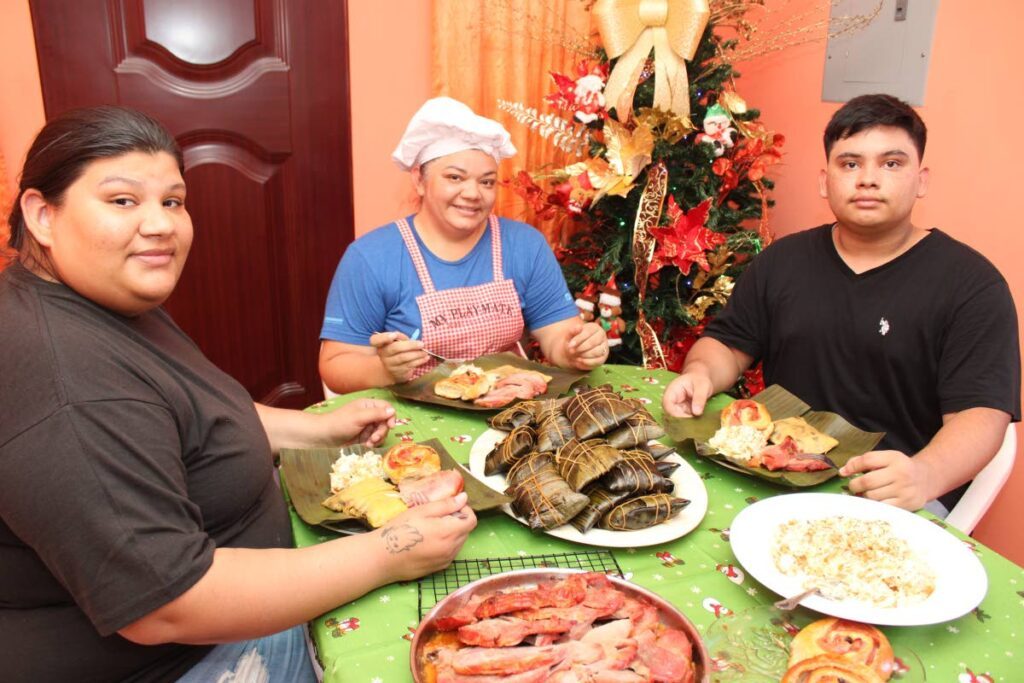
IF you are looking for something different to try for the holiday cooking, perhaps you may want to add hallaca to the menu. While hallaca is similar to the seasonal favourite, pastelle, it is different, and is described as a complete meal.
The Venezuelan hallaca is a special traditional dish prepared during the month of December to celebrate the Christmas festivities with the family.
It stands as the main dish on the table, always accompanied by ham bread, chicken salad and roast pork.
Hallaca is similar to pastelle but it's prepared differently.
Here in Trinidad and Tobago, Venezuelans Joanesa Cedeño and her children Izaura Gomez and Jhonwilmer Gomez specialise in preparing their country's hallacas. They have opened their own food business, Dulce & Salado, and hallaca is one of their main offerings.
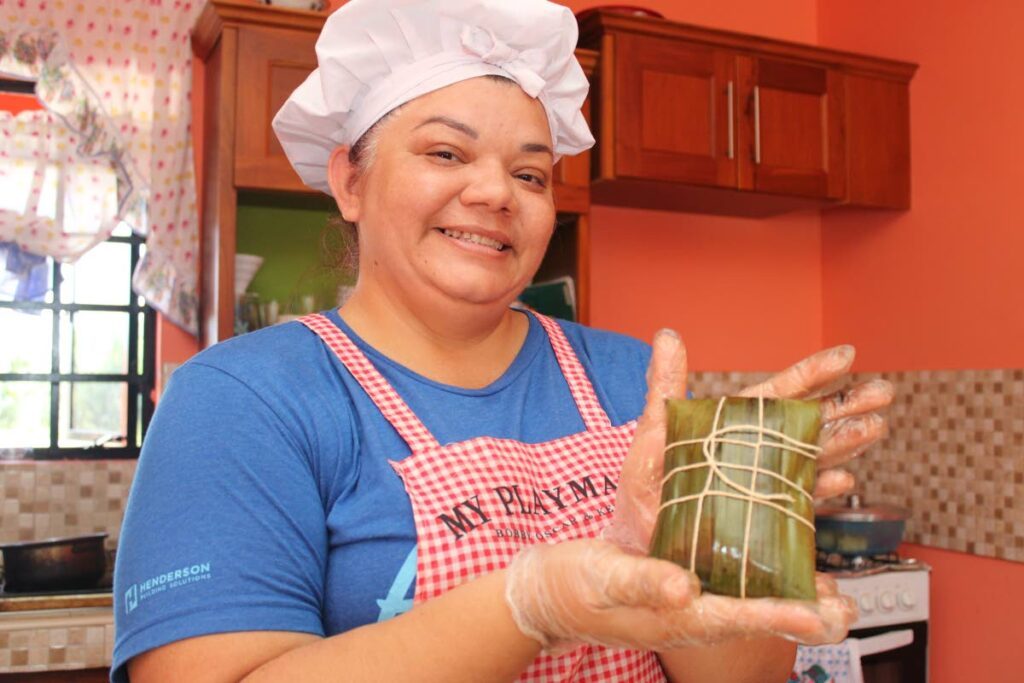
Cedeño explains: “The Venezuelan hallaca is a complete meal with a unique and unmistakable smell, made from ground corn, stuffed with meat and pork in stew, decorated with chicken or hen, olive, raisins, capers, egg, onion, potato, carrot and of course spices and a touch of special love, and after assembling it, giving it a peculiar square shape and wrapping it in a banana leaf and wick thread."
The most fun and dynamic way to prepare the hallacas is to use a large table and place the ingredients in an assembly line. Cedeño says hallacas can take up to two days to prepare, depending on the quantity you want to make.
Both in Venezuela and in TT getting the ingredients to make the hallacas is complex.
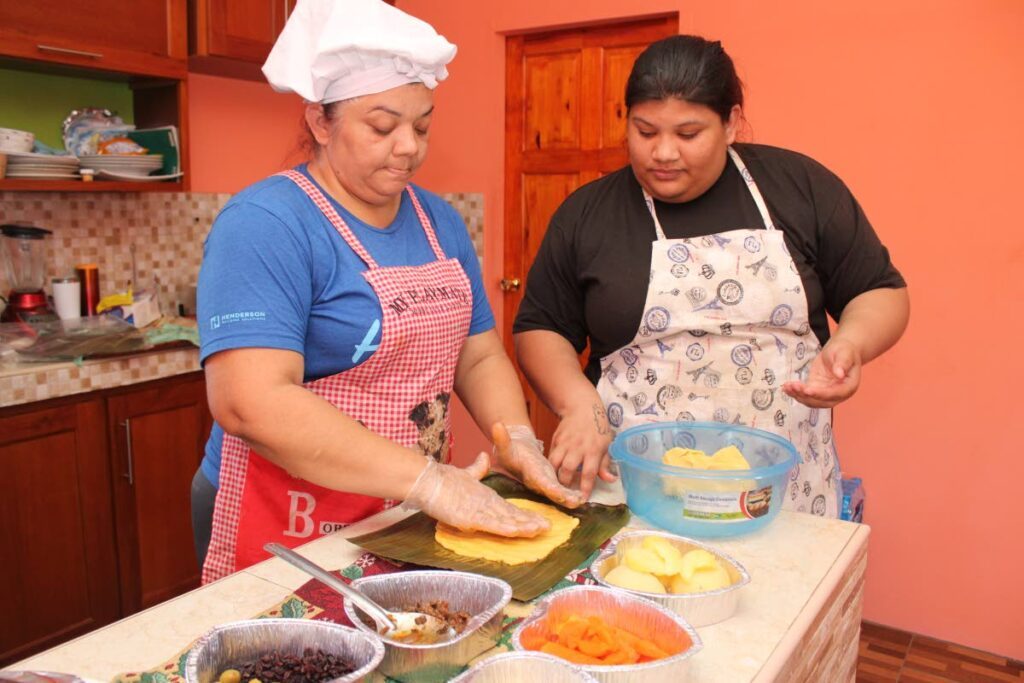
“We find many of the ingredients in different local businesses, but we implement cost strategies and some we bring through parcels from Venezuela.
“The hallaca is a 'poem' wrapped in banana leaves and Venezuelans make comparisons about which are the tastiest.”
She explains that Andean hallacas are prepared only with pork and chicken, strained corn dough and chickpeas. It is customary in some homes to leave the capers macerating in red wine, after being washed with water.
The oriental hallacas include three meats: beef, pork and poultry. Others have seafood (mussels,
pepitonas, chipichipis, dogfish, chucho or skate).
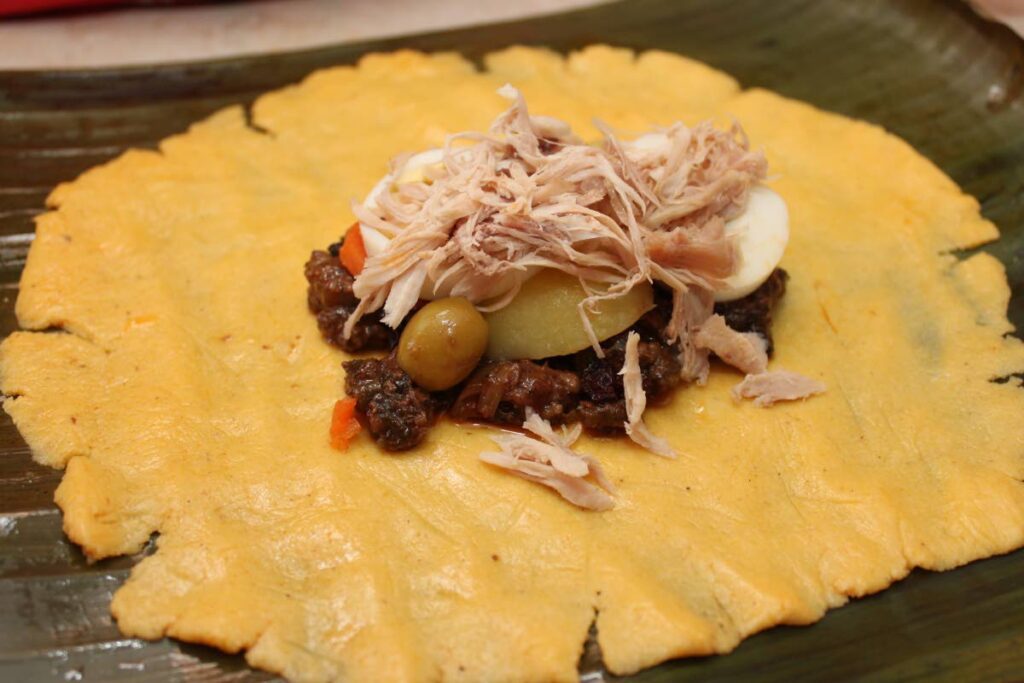
Hallacas from Caracas are a little sweet. They contain beef, pork and chicken, as well as bacon and tomatoes. Their dough is a little firmer than those in the rest of the country and may contain nuts such as almonds.
In Angostura hallacas prepared in the state of Barinas, the stew contains ground beef and pork. The pork and decorations are marinated in vinegar or orange juice.
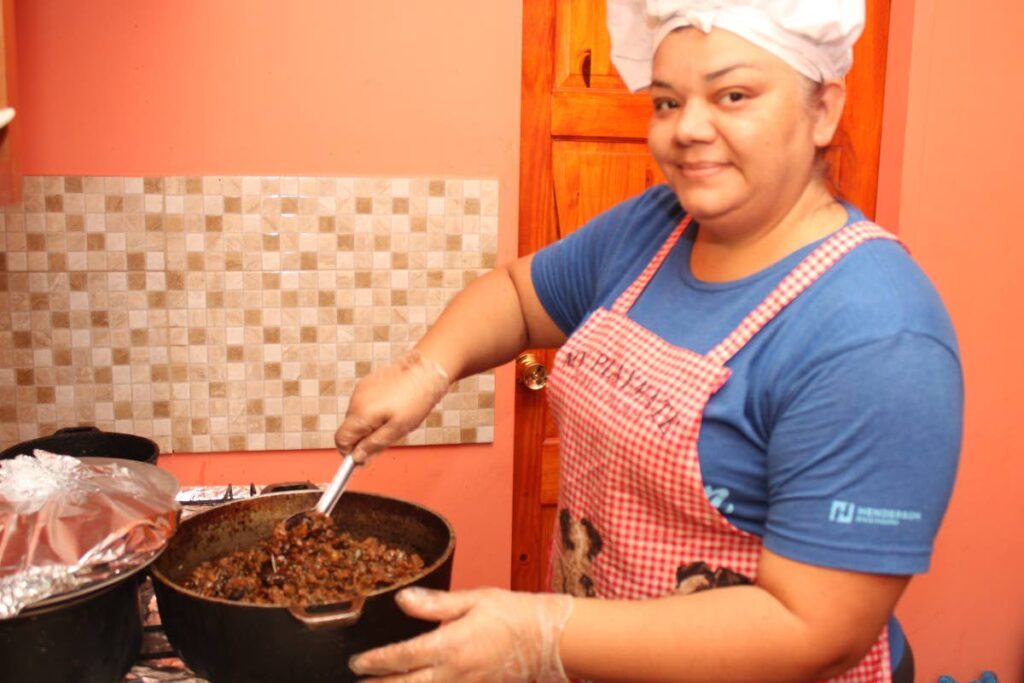
Comparing hallacas to pastelles, Cedeño says, “We can say it is different starting because the
hallaca is a corn cake and not wheat with a more elaborate stew and with more seasonings, unlike the TT pastelle, which is a rectangular-shaped tamale, but with a protein filling and wrapped in aluminium foil.”
Hallacas
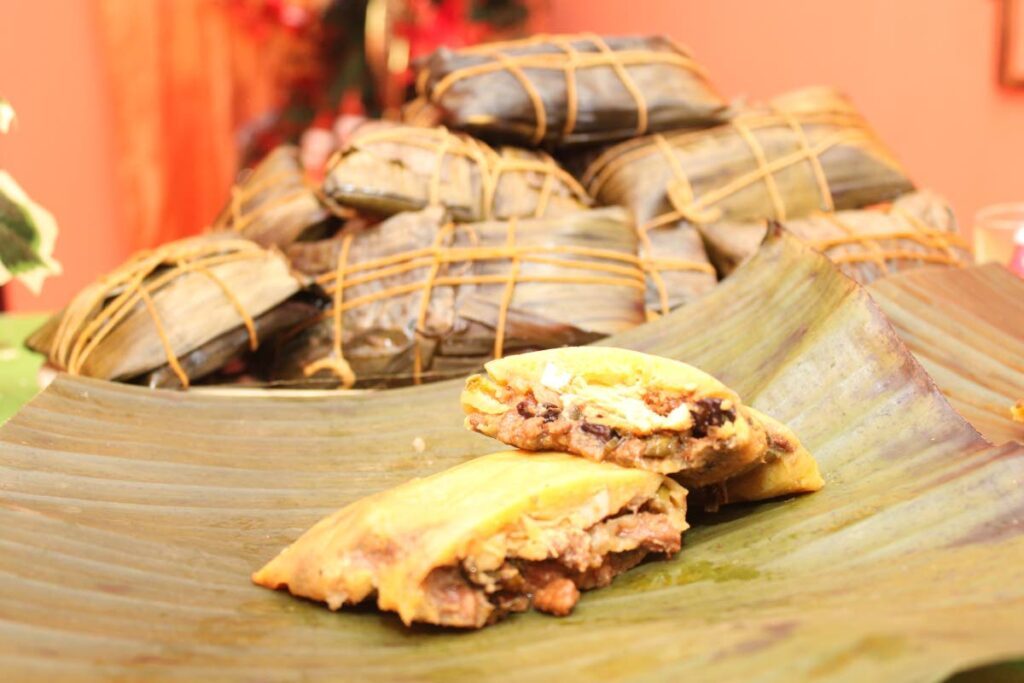
4½ lbs of beef
4½ lbs pork meat
4 lbs of boneless chicken
2½ lbs of bacon
4 lbs of skinless and seedless tomatoes
2 lbs of diced onions
6 diced sweet red peppers
2 diced green peppers
2 medium paprika diced
1 cup of minced chives
8 minced garlic cloves
1 tbs oregano
2 tbs salt
1 tbs cumin
1 tbs garlic powder
1½ tbs pepper
1½ bottle of red wine (25.4 oz)
12 lbs of banana leaves
1 cup of vegetable oil
Ingredient when assembling
Hallacas
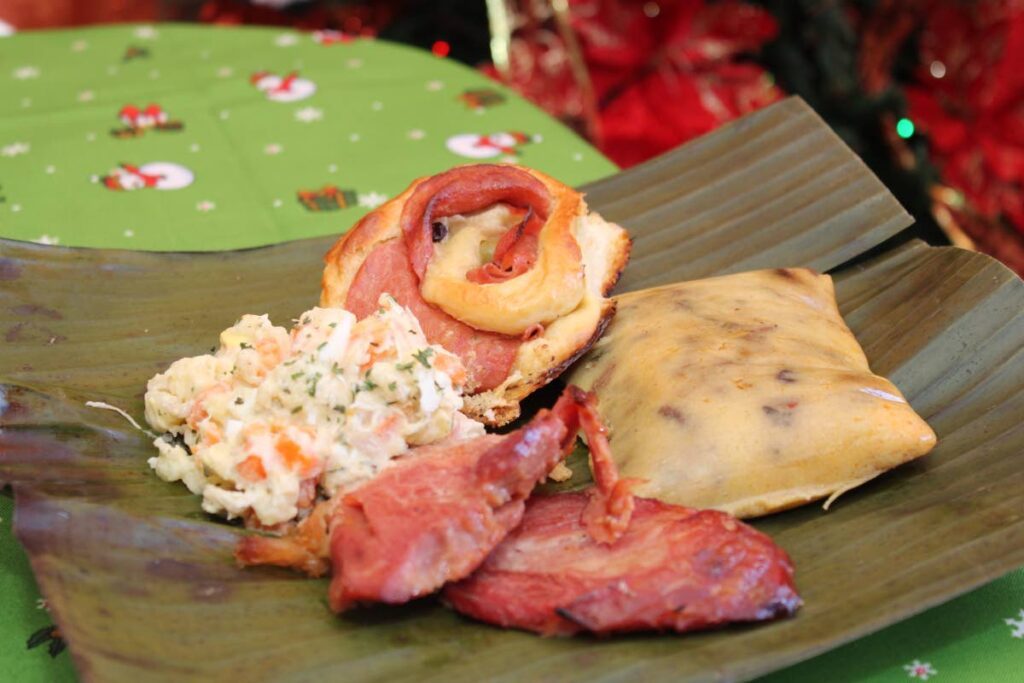
½ cup of vegetable oil
4 medium onions. Slice rings out of them.
3 red pepper. Cut long slices out of them.
4 cups parsley
1½ cups raisins
2 cups canned chickpeas
½ cup of caper
2 cups stuffed green olives without seeds
2 packs bacon cuts in little pieces
1 roll of cotton cooking twine
Preparation
Meat
Cut the beef, pork in dices of about 1 inch
Slice the bacon into small pieces..
Remove the skin and bones from chicken and cut in smaller pieces
Add all the meat into a pot with a lid
Add the onions, aji, onions, garlic in the pot.
Season pot with oregano, salt, cumin, garlic powder, wine, and the vegetable oil.
Mix them very well and let it sit overnight in the refrigerator.
To keep the mix consistency, Every couple of hours stir the content.
Banana leaves
Wash the leaves with water; clean them well with a damp cloth and dry them with a dry one.
Divide the leaves in two types:
one that's the main one (the biggest one) which is where you have to place the dough and
hallaca filling
second leaf (smaller one): that covers, encloses and protects the
hallaca while is cooking.
Remove the centre stem from the leaves, since this prevents them from bending easily.
Be careful not to break the leaf while you remove the stem, with the help of scissors.
Dough
1 cup of pork fat/butter
1 cup of ground annatto or annatto powder
3 packs of cornmeal (2 lbs each)
15 cups of chicken broth
4½ cups of room temperature butter (unsalted)
salt to taste
Heat up a saucepan at medium heat.
Add the pork fat and annatto grains.
Let the pork fat dissolve and the annatto to render its colour.
Remove from the stove and let cool.
In a large container, add the corn flour and incorporate little by little with the chicken broth, and the softened butter.
Knead vigorously and add the pork fat with annatto and salt to taste.
The dough has to be soft and with a yellow colour.
Divide the dough in 50 equal balls.
Assemble hallaca
Dampen a large leaf with a bit of vegetable oil.
Place one ball of dough in the middle of a leaf.
Extend the dough in a circular motion with your hands until it is of a 1/4-inch thick.
Add one tablespoon and a half of guiso with its juice in the centre of the dough.
On top of the filling, place 2 onion rings, 1 pepper strip, one parsley sprig, 3 raisins, 2 chickpeas, 2 capers, 2 olives and a small piece of bacon.
Fold the leaves:
Take the wider edges and attach them upward.
Create a fold until it is completely sealed.
Fold the other two ends towards the inside and wrap it with the smaller leaf.
Tie the
hallacas with the previously cut yarn (of approximately 1 metre and a half length).
Cross them three times in each direction (horizontal and vertical) and close with a knot or bow.
Cooking Hallaca
In a large pot, boil 8 gallons of water at high heat.
Place the hallacas, cover and cook them to low heat for a period of an hour and a half.
Repeat the process with the other hallacas or you can use two pots at the same time.
Storing
Remove and drain, preferably in the vertical position.
Let cool and refrigerate until you are ready to eat.
When you need to heat the hallacas again, boil water in a deep pot at high heat. Add the
hallacas you wish to reheat (make sure the water is covering them).
Lower the heat to medium and cook for 20 minutes. Remove the pot from the stove. Drain the
hallacas, cut the yarn, remove the leaf and enjoy!
Recipe courtesy Antillean Eats

Comments
"Hallacas – a Venezuelan Christmas staple"